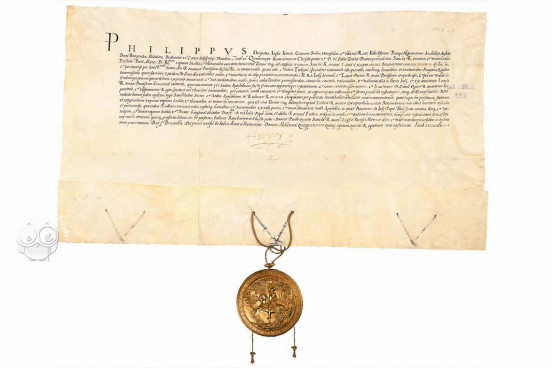The secret archives in the Vatican contain the most valuable and most famous collection of gold and silver seals in the world: 81 exceptional pieces dating from the 12th to the 19th centuries. 64 of them are in gold plate, 13 of them are wax seals with gold cases, and 4 are in solid gold. Among the latter is the seal that was affixed to a ceremonial document (A.A., Arm. I-XVIII, 522) sent by Philip II to Pope Paul IV in 1555. Since that date, this work of art has been kept in the Pope's private archive, and is said to be the most beautiful seal conserved in the Vatican.
The document validated by this seal was written at a critical moment in relations between the Holy See and the Spanish monarchy, represented at that time by Emperor Charles V. The sending of this document and the gift to the Pontiff of an art work containing 800 grams of gold could be considered as an attempt to calm the political tensions between Spain and the Holy See, but it might equally have been intended as a veiled warning from the Spanish prince that the Pope's policies could lead to confrontation with the wealthiest and most powerful monarchy in Europe. In any case, the tensions were not eliminated and the ensuing war between Spain and the Pope and his ally the king of France ended with a Spanish victory at St. Quentin (1557).
The substance of the letter is in the tradition of the longstanding formal pledge which any new ruler of the Kingdom of the Two Sicilies (which included Naples, known as Sicilia Citerior, and Sicily itself, known as Sicilia Ulterior) had to send the Pope as an oath of loyalty on investiture to the Kingdom, acknowledging explicitly that the title depended on the sole grace and munificence of the Apostolic See. In this particular document, Philip II, associating the title of King of England with the titles of the Spanish monarchy, recalls that possession of Sicily and Jerusalem had been reserved by the Sovereign Pontiffs for the Kings of Aragon during the papacies of Julius II and Leo X, in exchange for an annual tribute and compliance with a number of other conditions and how Charles V, his father, had renounced the kingdoms concerned in his favor and Pope Julius III had consented to the investiture. This was the reason that he had ordered that this letter, with its gold seal, should be sent, as a testimony of fealty, to Paul IV, Julius III's successor on the throne of Peter.
We have 1 facsimile edition of the manuscript "Oath of Loyalty sworn to Pope Paul IV by Philip II on his investiture as King of Sicily": Juramento de fidelidad al Papa Paulo IV facsimile edition, published by Testimonio Compañía Editorial, 1998
Request Info / Price

